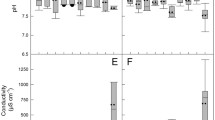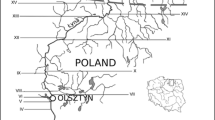Abstract
The Scheldt watershed is characterized by a high population density, intense industrial activities and intensive agriculture and breeding. A monthly monitoring (n = 16) of the abundance of two faecal indicator bacteria (FIB), Escherichia coli and intestinal enterococci (IE), showed that microbiological water quality of the main rivers of the Scheldt drainage network was poor (median values ranging between 1.4 × 103 and 4.0 × 105 E. coli (100 mL) − 1 and between 3.4 × 102 and 7.6 × 104 IE (100 mL) − 1). The Zenne River downstream from Brussels was particularly contaminated. Glucuronidase activity was measured in parallel and was demonstrated to be a valid surrogate for a rapid evaluation of E. coli concentration in the river waters. FIB were also investigated in the river sediments; their abundance was sometimes high (average values ranging between 2.1 × 102 and 3.3 × 105 E. coli g − 1 and between 1.0 × 102 and 1.7 × 105 IE g − 1) but was not sufficient to contribute significantly to the river water contamination during resuspension events, except for the Scheldt and the Nethe Rivers. FIB were also quantified in representative point sources (wastewater treatment plants) and non-point sources (runoff water and soil leaching on different types of land use) of faecal contamination. The comparison of the respective contribution of point and non-point sources at the scale of the Scheldt watershed showed that point sources were largely predominant.
Similar content being viewed by others
References
An, Y. -J., Kampbell, D. H., & Briedenbach, G. P. (2002). Escherichia coli and total coliforms in water and sediment at lake marinas. Environmental Pollution, 120(3), 771–778.
Anderson, K. L., Whitlock, J. E., & Harwood, V. J. (2005). Persistence and differential survival of fecal indicator bacteria in subtropical waters and sediments. Applied and Environmental Microbiology, 71(6), 3041–3048.
Bossard, M., Feranec, J., & Otahel, J. (2000). CORINE land cover technical guide: Addendum 2000. Copenhagen: European Environment Agency.
Crabill, C., Donald, R., Snelling, J., Foust, R., & Southam, G. (1999). The impact of sediment fecal coliform reservoirs on seasonal water quality in Oak creek, Arizona. Water Research, 33(9), 2163–2171.
Craig, D. L., Fallowfield, H. J., & Cromar, N. J. (2002a). Enumeration of faecal coliforms from recreational coastal sites: Evaluation of techniques for the separation of bacteria from sediments. Journal of Applied Microbiology, 93(4), 557–565.
Craig, D. L., Fallowfield, H. J., & Cromar, N. J. (2002b). Comparison of the decay rates of faecal indicator organisms in recreational coastal water and sediment. Water Science and Technology: Water Supply, 2(3), 131–138.
Craig, D. L., Fallowfield, H. J., & Cromar, N. J. (2004). Use of microcosms to determine persistence of Escherichia coli in recreational coastal water and sediment and validation with in situ measurements. Journal of Applied Microbiology, 96(5), 922–930.
Davies, C. M., Long, J. A. H., Donald, M., & Ashbolt, N. J. (1995). Survival of fecal microorganisms in marine and freshwater sediments. Applied and Environmental Microbiology, 61(5), 1888–1896.
Edberg, S. C., Rice, E. W., Karlin, R. J., & Allen, M. J. (2000). Escherichia coli: The best biological drinking water indicator for public health protection. Journal of Applied Microbiology, 88, 106S–116S.
EPA (1999) United States Environmental Protection Agency, 1999. Action plan for beaches and recreational waters. EPA 600-R-98/079. Washington, DC: EPA.
EU (2006). Directive 2006/7/EC of the European Parliament and of the Council of 15 February 2006 concerning the management of bathing water quality. Official Journal of the European Union, 64, 37–51.
Farnleitner, A. H., Hocke, L., Beiwl, C., Kavka, G. G., Zechmeister, T., Kirschner, A. K. T., et al. (2001). Rapid enzymatic detection of Escherichia coli contamination in polluted river water. Letters in Applied Microbiology, 33(3), 246–250.
Feachem, R. (1975). An improved role for faecal coliform to faecal streptococci ratios in the differentiation between human and non-human pollution sources. Water Research, 9(7), 689–690.
Fewtrell, L., & Bartram, J. (2001). Water quality: Guidelines, standards and health. World Health Organization Water Series (pp. 20–21). London: IWA.
Fiksdal, L., Pommepuy, M., Caprais, M. P., & Midttun, I. (1994). Monitoring of fecal pollution in coastal waters by use of rapid enzymatic techniques. Applied and Environmental Microbiology, 60(5), 1581–1584.
Garcia-Armisen, T., Lebaron, P., & Sevais, P. (2005). β-D-Glucuronidase activity assay to assess viable Escherichia coli abundance in freshwaters. Letters in Applied Microbiology, 40(4), 278–282.
Garcia-Armisen, T., & Servais, P. (2007). Respective contributions of point and non point sources of E. coli and enterococci in a large urbanised watershed (the Seine River, France). Journal of Environmental Management, 82(4), 512–518.
Geldreich, E. E. (1976). Fecal coliform and fecal streptococcus density relationships in waste discharges and receiving waters. Critical Reviews on Environmental Control, 6, 349–369.
George, I., Anzil, A., & Servais, P. (2004). Quantification of fecal coliforms inputs to aquatic systems through soil leaching. Water Research, 38(3), 611–618.
George, I., Crop, P., & Servais, P. (2002). Fecal coliforms removal in wastewater treatment plants studied by plate counts and enzymatic methods. Water Research, 36(10), 2607–2617.
George, I., Petit, M., & Servais, P. (2000). Use of enzymatic methods for rapid enumeration of coliforms in freshwaters. Journal of Applied Microbiology, 88(3), 404–413.
Hoch, B., Berger, B., Kavka, G., & Herndl, G. (1996). Influence of wastewater treatment on the microbial ecology of a large, temperate river system—the Danube River. Hydrobiologia, 321(3), 205–218.
Jagals, P., Grabow, W. O. K., & de Villiers, J. C. (1995). Evaluation of indicators for assessment of human and animal faecal pollution of surface run-off. Water Science and Technology, 31(5–6), 235–241.
Kinzelman, J., Ng, C., Jackson, E., Gradus, S., & Bagley, R. (2003). Enterococci as indicators of lake Michigan recreational water quality: Comparison of two methodologies and their impacts on public health regulatory events. Applied and Environmental Microbiology, 69(1), 92–96.
Kirschner, A. K. T., Kavka, G., Velimirov, B., Mach, R. L., Sommer, R., & Farnleitner, A. H. (2009). Microbiological water quality along the Danube River: Integrating data from two whole-river surveys and a transnational monitoring network. Water Research, 43(15), 3673–3684.
Lebaron, P., Henry, A., Lepeuple, A. S., Pena, G., & Servais, P. (2005). An operational method for real-time monitoring of E. coli in bathing waters. Marine Pollution Bulletin, 50(6), 652–659.
Lee, C. M., Lin, T. Y., Lin, C.-C., Kohbodi, G. A., Bhatt, A., Lee, R., et al. (2006). Persistence of fecal indicator bacteria in Santa Monica Bay beach sediment. Water Research, 40(14), 2593–2602.
Miranda, J. M., Franco, C. M., Vàzquez, B. I., Fente, C. A., Barros-Velàzquez, J., & Cepeda, A. (2005). Evaluation of Chromocult enterococci agar for the isolation and selective enumeration of Enterococcus spp. in broilers. Letters in Applied Microbiology, 41(2), 153–156.
Muirhead, R. W., Davies-Colley, R. J., Donnison, A. M., & Nagels, J. W. (2004). Faecal bacteria yields in artificial flood events: Quantifying in-stream stores. Water Research, 38(5), 1215–1224.
Nagels, J. W., Davies-Colley, R. J., Donnison, A. M., & Muirhead, R. W. (2002). Faecal contamination over flood events in a pastoral agricultural stream in New Zealand. Water Science and Technology, 45(12), 45–52.
Prats, J., Garcia-Armisen, T., Larrea, J., & Servais, P. (2008). Comparison of culture-based methods to enumerate Escherichia coli in tropical and temperate freshwaters. Letters in Applied Microbiology, 46(2), 243–248.
Roslev, P., Bastholm, S., & Iversen, N. (2008). Relationship between fecal indicators in sediment and recreational waters in Danish estuary. Water Air and Soil Pollution, 194(1–4), 13–21.
Servais, P., Garcia-Armisen, T., George, I., & Billen, G. (2007). Fecal bacteria in the rivers of the Seine drainage network (France): Sources, fate and modelling. Science of the Total Environment, 375(1–3), 152–167.
Servais, P., Garcia-Armisen, T., Lepeuple, A. S., & Lebaron, P. (2005). An early warning method to detect faecal contamination of river waters. Annals of Microbiology, 55(2), 151–156.
Servais, P., Prats, J., Passerat, J., & Garcia-Armisen, T. (2009). Abundance of culturable versus viable Escherichia coli in freshwaters. Canadian Journal of Microbiology, 55(7), 905–909.
Schilling, K. E., Zang, Y. K., Hill, D. R., Jones, C. S., & Wolter, C. F. (2009). Temporal variations of Escherichia coli concentrations in large Midwestern river. Journal of Hydrology, 365, 79–85.
Smith, J., Edwards, J., Hilger, H., & Steck, R. T. (2008). Sediment can be a reservoir for coliform bacteria released into streams. Journal of General and Applied Microbiology, 54(3), 173–179.
Strahler, A. N. (1957). Quantitative analysis of watershed geomorphology. Transactions of the American Geophysical Union, 38(6), 913–920.
Tryland, I., Surman, S., & Berg, J. D. (2002). Monitoring faecal contamination of the Thames estuary using semi automated early warning system. Water Science and Technology, 46(3), 25–31.
Author information
Authors and Affiliations
Corresponding author
Rights and permissions
About this article
Cite this article
Ouattara, N.K., Passerat, J. & Servais, P. Faecal contamination of water and sediment in the rivers of the Scheldt drainage network. Environ Monit Assess 183, 243–257 (2011). https://doi.org/10.1007/s10661-011-1918-9
Received:
Accepted:
Published:
Issue Date:
DOI: https://doi.org/10.1007/s10661-011-1918-9




